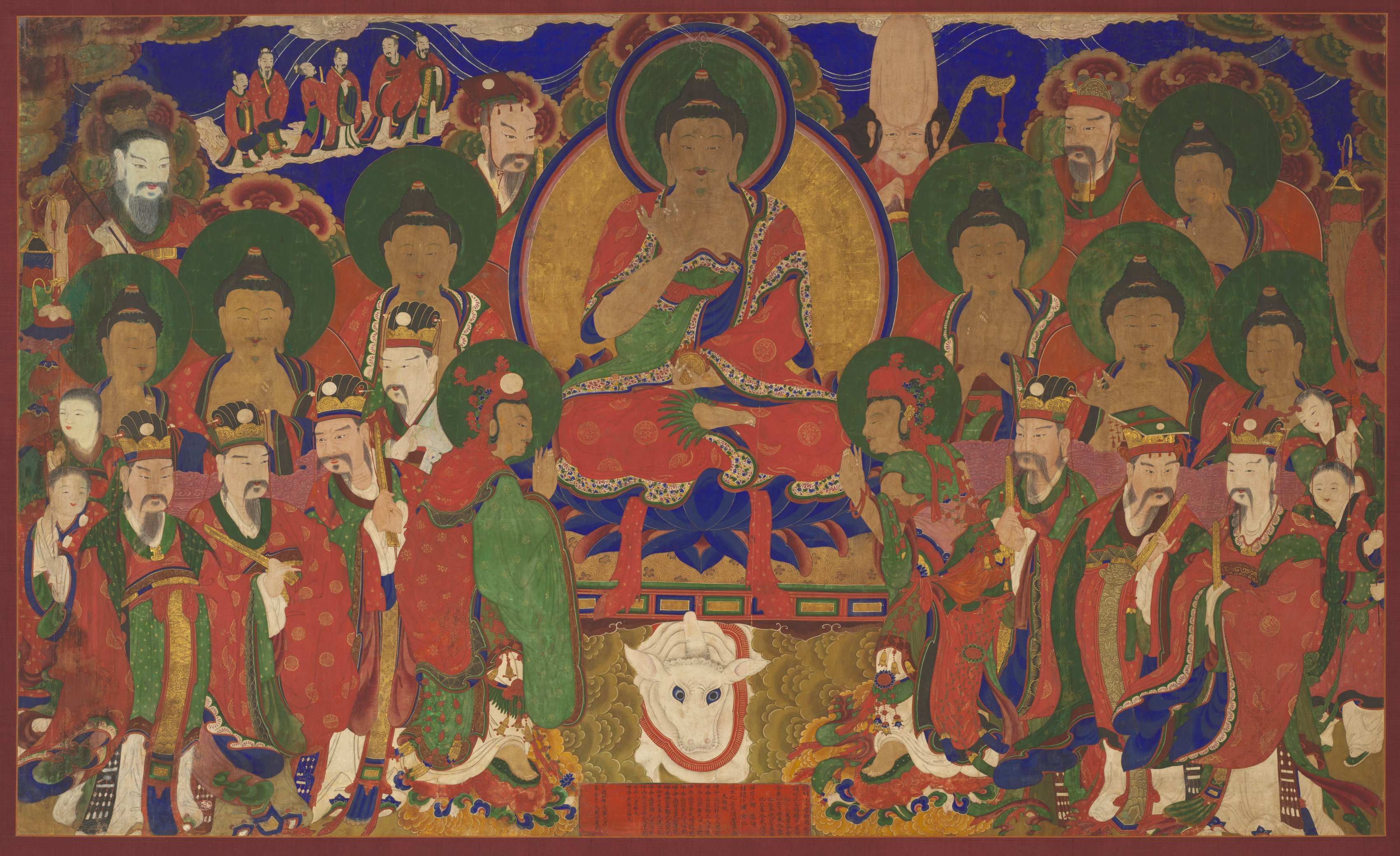The Cleveland Museum of Art
Collection Online as of April 20, 2024

The Assembly of Tejaprabha Buddha
1878
Location: not on view
Did You Know?
The central Buddha of Radiant Light is flanked by two attendant bodhisattvas, Sunlight and Moonlight, each in reverence posture.Description
The main deity seated at the center is Tejaprabha, the Buddha of Radiant Light. Blazing beams of light emanating from its celestial body are this deity’s weapon to crush all kinds of calamities. Coincidently, when this painting was created, Korea was experiencing a height of foreign military aggressions, including invasions by the French (1866) and the US (1871). The inscription at the bottom center states that a group of ladies from the royal court commissioned the scroll to wish for the well-being of their families. During the late Joseon dynasty, Korean women became largely marginalized. Nevertheless, they remained important patrons of Buddhist art and architecture, voicing their concerns for their country and families in peril.- Emerald Green: Toxic Pigment
Analysis of The Assembly of Tejaprabha Buddha led to the discovery that the light green pigment—mainly applied to some of the clothing—was not the finely ground malachite traditionally used, but was copper acetoarsenite. Commonly referred to as emerald green, this pigment was discovered in the early 1800s and first commercially manufactured in 1814.
Extremely poisonous, it was often used as an insecticide during the 19th and early 20th centuries. X-ray fluorescence (XRF) spectroscopy, a noninvasive analytical technique, revealed the presence of copper and arsenic. Further analysis of a small sample by Fourier-transform infrared (FTIR) spectroscopy confirmed emerald green. With this newly gained information, conservators must handle this work with caution, using gloves and masks. - ?-1998Mitsura Tajima, Tokyo, Japan, given to the Cleveland Museum of Art1998-The Cleveland Museum of Art, Cleveland, OH
- Treasures from Korea: Arts and Culture of the Joseon Dynasty, 1392-1910. Philadelphia: Philadelphia Museum of Art, 2014.Yi, Yong-yoon. “Bokjang Dedicated to Buddhist Paintings of the Late Joseon Period [조선후기 佛畵의 腹藏 연구].” Misulsahak yeongu (2016): 121-154. www.dbpia.co.krChoe, Yeob. “A Study of Subjects in the Inscriptions of Buddhist Paintings [불화 畵記의 畵題 및 명칭 검토].” Misulsa nondan (2017): 205-225. www.dbpia.co.krGalerie Jacques Barrère. Japan = Nihon. Paris, France: Galerie Jacques Barrère, 2019. Mentioned: p. 61Kim, Jeong-hee. Royal House, Power and Buddhist Painting [왕실, 권력 그리고 불화]. Seoul: Sechang chulpansa, 2019.Ch'a, Mi-rae, Kwi-suk An, Cleveland Museum of Art, and 국외소재문화재재단. The Korean Collection of the Cleveland Museum of Art. Edited by An Min-hŭi. First edition, English ed. Overseas Korean Cultural Heritage Series, 16. Seoul, Republic of Korea: Overseas Korean Cultural Heritage Foundation, 2021. Mentioned and reproduced: p. 164-165, no. 107
- The Other Side of the Story - Korean Gallery 236 Rotation. The Cleveland Museum of Art (organizer) (October 27, 2020-April 25, 2021).Main Asian Rotation (Gallery 237). The Cleveland Museum of Art, Cleveland, OH (December 23, 2013-January 12, 2015).
- {{cite web|title=The Assembly of Tejaprabha Buddha|url=false|author=|year=1878|access-date=20 April 2024|publisher=Cleveland Museum of Art}}
Source URL:
https://www.clevelandart.org/art/1998.120